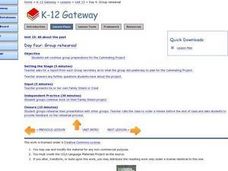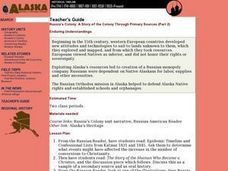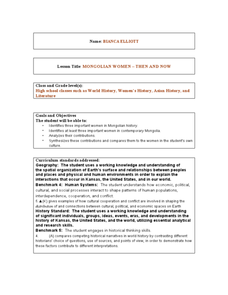Curated OER
The Russian View of Territorial Encroachment
Twelfth graders produce a map illustrating the current NATO members, future nations, and nations that have applied for membership. They research current information regarding NATO, and the Russian viewpoint about the expansion of NATO....
Curated OER
The Cause and Course of the Great War
Students interpret historical evidence presented in primary and secondary resources. In this World War I lesson, students research the causes of the war as well as the major events of the war. Students are...
Curated OER
Group Rehearsal
Pupils study their national and family heritage while working in groups. In this personal history project, students examine the family shield or crest of the teacher while preparing to create and share their own with the class. Pupils...
Curated OER
African Architecture
Seventh graders investigate cultural influences on architecture in Africa south of the Sahara. They compare the architecture to that in North America, Europe, Russia, and North Africa, Asia, and South America.
Curated OER
Celebrate Sunflowers
Students skip count with sunflower seeds. In this interdisciplinary lesson, students discuss the history of sunflowers. Students count by 1's, 2's, and 10's with bags full of sunflower seeds.
Facing History and Ourselves
We and They, the Armenians in the Ottoman Empire
Learners examine World War I war crimes. For this world history instructional activity, learners use primary and secondary sources to research and understand the action taken by the United States during the Armenian Genocide. Learners...
Curated OER
The Influence of The Byzantine Empire on Russia and Eastern Europe
Students examine the influence on Russian and Eastern European language, religion, art, and architecture by the Byzantine Empire. They define key vocabulary terms, listen to a lecture and participate in a class discussion, and label a map.
Curated OER
The Calendar
Learners engage in an overview of solar and lunar calendars, their history and lore. Also, of the day and the month, and their relations to the rotation period of the Earth and the orbital period of the Moon.
Curated OER
Russia's Colony: A Story of the Colony Through Primary Sources
Students read "Epidemic Timeline and Confessional Lists from Katmai 1831 and 1845." They construct a picture of life in Alaska during the Russian period.
Curated OER
Russia's Colony: A Story of the Colony Through Primary Sources (Part 1)
Students review the Russian American Timeline connected to the Russia's Colony unit narrative.
Curated OER
Gold Rush Abolitionists: How different was the role of Spanish-speaking blacks under Mexican rule from the role of English-speaking blacks under U.S. rule?
Students determine how Spanish-speaking blacks and English speaking blacks were treated differently. In this emancipation lesson plan, students compare the Mexican and American rules regarding slavery.
Curated OER
MONGOLIAN WOMEN - THEN AND NOW
Students are introduced to the history of Mongolia. This is a general overview before going into the real detail of the lesson. The main focus is upon the development of the women of Mongolia and the major contributions they have made.
Curated OER
Fur Trade Economics
Students demonstrate understanding of what the fur trade was and how it was operated, including the bartering process, by participating in a mock trade activity and assessing the value of items based on their needs and wants.
Curated OER
South Asian Architecture
Seventh graders review and discuss architecture from South Asia. They then study images of various buildings from North Africa/Southwest Asia, and make comparisons
Curated OER
John Paul Jones: Captain of the High Seas
Young scholars explore John Paul Jones. His sense of adventure brought him to America. His bravery made him the country's greatest naval hero.
Curated OER
Out With the Old, in With the New
Students engage in a lesson that is concerned with the concept of the Soviet Union and compared to the new Democratic Russia. They conduct research using a variety of resources. The information is used in order to create a class project.
Curated OER
A Constitution for Alaska
Students read sections cited from the Governing Alaska unit. They discuss factors that made Alaskans push for statehood. They view video A Constitution for Alaska.
Curated OER
What's So Great About Peter?
Students research the origins of the name of their town or city. They pick another city and do the same, individually. They also write a bio poem about a historical figure.
Curated OER
Animal Farm - The Rest of the Story
Students participate in a reader's theater using farm animals in the novella Animal Farm. In this Animal Farm lesson plan, students evaluate interpretations using the text, personal experience, and historical events.
Curated OER
Using A Winogradsky Column to Analyze Microbial Communities
Young scholars use easily obtained materials to study ecological succession in a microbiological community. This investigation is appropriate for a variety of age groups. Elementary Students be fascinated by the changes occurring over...
Curated OER
Using A Winogradsky Column to Analyze Microbial Communities
Students use easily obtained materials to study ecological succession in a microbiological community. They collect water samples from outdoor sources in plastic bottles to observe and record changes.






















